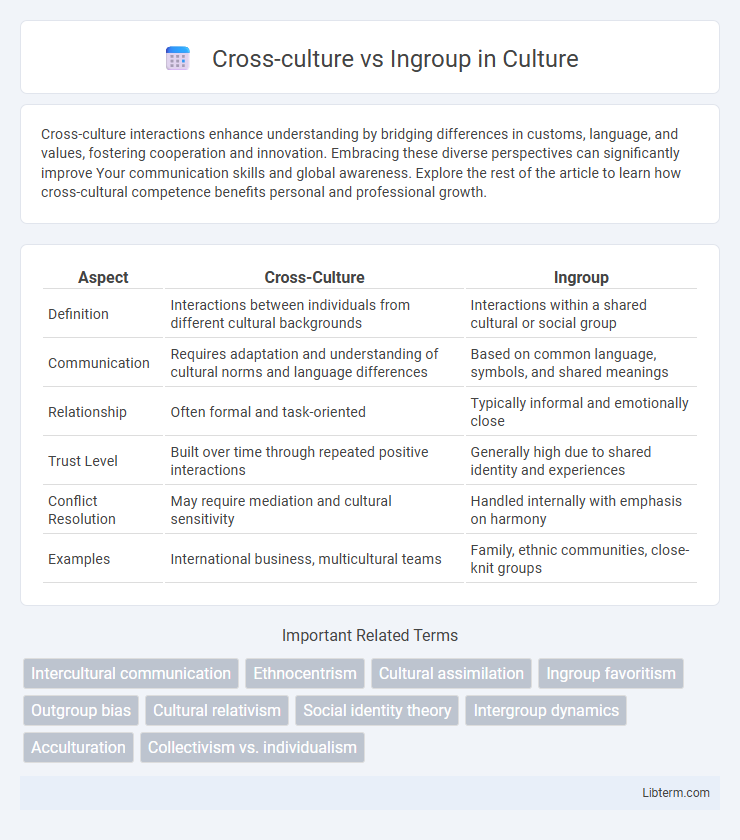Cross-culture interactions enhance understanding by bridging differences in customs, language, and values, fostering cooperation and innovation. Embracing these diverse perspectives can significantly improve Your communication skills and global awareness. Explore the rest of the article to learn how cross-cultural competence benefits personal and professional growth.
Table of Comparison
| Aspect | Cross-Culture | Ingroup |
|---|---|---|
| Definition | Interactions between individuals from different cultural backgrounds | Interactions within a shared cultural or social group |
| Communication | Requires adaptation and understanding of cultural norms and language differences | Based on common language, symbols, and shared meanings |
| Relationship | Often formal and task-oriented | Typically informal and emotionally close |
| Trust Level | Built over time through repeated positive interactions | Generally high due to shared identity and experiences |
| Conflict Resolution | May require mediation and cultural sensitivity | Handled internally with emphasis on harmony |
| Examples | International business, multicultural teams | Family, ethnic communities, close-knit groups |
Defining Cross-Culture and Ingroup Dynamics
Cross-culture refers to interactions between individuals from different cultural backgrounds, emphasizing diverse values, beliefs, and communication styles. Ingroup dynamics involve the behaviors, norms, and loyalty patterns exhibited by members within a specific cultural or social group. Understanding cross-cultural communication requires analyzing how ingroup perceptions influence trust, collaboration, and conflict resolution across diverse societies.
Historical Perspectives on Cross-Cultural Interaction
Historical perspectives on cross-cultural interaction reveal patterns of trade, conquest, and diplomacy that shaped ingroup identities and outgroup perceptions. These interactions fostered cultural exchange and syncretism, influencing language, religion, and social customs while often reinforcing ingroup cohesion. Understanding these dynamics provides insight into the complexities of cultural integration and conflict throughout history.
Psychological Foundations of Ingroup Behavior
Ingroup behavior is rooted in psychological foundations such as social identity theory, which explains how individuals categorize themselves and others into groups to establish a sense of belonging and self-esteem. Cross-cultural studies reveal variations in ingroup favoritism, with collectivist cultures emphasizing harmony and loyalty within the ingroup, while individualist cultures highlight personal achievement even within group contexts. Mechanisms like ingroup bias, conformity, and social facilitation drive behaviors that reinforce group cohesion and delineate boundaries between ingroup and outgroup members.
Communication Barriers: Cross-Culture vs Ingroup
Communication barriers in cross-culture interactions often stem from language differences, varying nonverbal cues, and contrasting cultural norms that can lead to misunderstandings and misinterpretations. Ingroup communication barriers typically arise from shared assumptions, exclusive jargon, and implicit behaviors that outsiders find difficult to decode, causing social exclusion and reduced information flow. Successfully navigating these barriers requires awareness of cultural diversity in cross-culture settings and conscious inclusion efforts within ingroups to foster clear and effective communication.
Identity Formation in Diverse Cultures
Identity formation in diverse cultures involves navigating the complex interplay between cross-cultural influences and ingroup dynamics. Cross-culture interactions expose individuals to varying norms, values, and beliefs, promoting adaptability and intercultural competence, while ingroup affiliation reinforces a sense of belonging, shared identity, and collective memory. Balancing these factors shapes a multifaceted self-concept, fostering inclusivity and resilience amidst cultural pluralism.
Social Bias and Stereotyping Across Groups
Social bias and stereotyping manifest distinctly in cross-cultural interactions compared to ingroup dynamics, with cross-culture scenarios often amplifying cognitive biases due to unfamiliar customs and communication styles. Ingroup favoritism intensifies selective perception, reinforcing stereotypes within homogeneous groups and limiting exposure to diverse perspectives. Research in social psychology and intercultural communication emphasizes that addressing these biases requires targeted strategies such as perspective-taking and intercultural competence to reduce prejudice and foster mutual understanding.
Conflict Resolution: Ingroup Loyalty vs Cross-Cultural Understanding
Ingroup loyalty often prioritizes harmonious relationships and trust within a familiar group, leading to conflict resolution strategies that emphasize consensus and conformity. Cross-cultural understanding encourages recognizing diverse perspectives and adapting communication styles to bridge differences, fostering inclusive and creative solutions. Balancing ingroup loyalty with cross-cultural sensitivity enhances conflict resolution by integrating trust-based cohesion with openness to diverse viewpoints.
Collaboration and Innovation through Cultural Diversity
Collaboration between cross-culture teams and ingroups leverages diverse perspectives to drive innovation, enabling organizations to solve complex problems more creatively. Cultural diversity exposes teams to varied cognitive frameworks and problem-solving approaches, enhancing adaptability and fostering breakthrough ideas. Effective management of cross-cultural dynamics minimizes misunderstandings and builds trust, which is essential for maximizing collaborative innovation.
Case Studies: Cross-Cultural Success Stories vs Ingroup Cohesion
Case studies reveal that cross-cultural success stories often hinge on leveraging diverse perspectives to foster innovation and global market adaptability, contrasting with ingroup cohesion which emphasizes homogeneity and internal trust within a single cultural framework. For example, multinational corporations like IBM and Unilever demonstrate how cross-cultural teams enhance problem-solving by integrating varied cultural insights, whereas organizations with strong ingroups prioritize stability and rapid coordination among familiar members. The comparative analysis underscores that cross-cultural collaboration drives expansive growth and creativity, while ingroup-focused approaches optimize operational efficiency and social solidarity.
Future Challenges and Opportunities in a Globalized World
Cross-culture dynamics and ingroup biases shape future challenges in global collaboration, requiring enhanced intercultural competence and adaptive communication strategies. Navigating cultural diversity offers opportunities for innovation, inclusive leadership, and expanded market reach in an interconnected economy. Emphasizing mutual respect and cultural intelligence fosters resilience and competitive advantage in addressing global issues and workforce diversification.
Cross-culture Infographic

 libterm.com
libterm.com